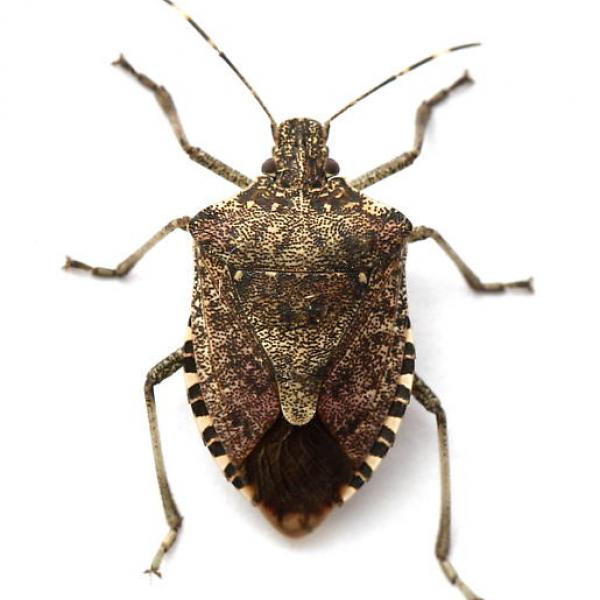
Most of us have become accustomed to seeing Halloween lady beetles, boxelder bugs and western conifer seed bugs on and in our homes in the fall. Here’s a new critter to add to that nuisance list: the brown marmorated stink bug (BMSB), Halyomorpha halys.
Besides being an annoyance when it seeks protected, overwintering sites on warm fall days, the BMSB can be a serious pest to over 100 host plants in agricultural settings and natural communities. Fruits, vegetables, and other cultivated crops are at risk in some areas. Considered an emerging pest in Vermont, special concerns in our state include tree fruits and grapes, but at present, the insect is mainly drawing attention as a household invader.
The first North American sightings of this Asian species were made in the late 1990s in Allentown, PA. However, like so many newly-recognized invasives, the insect likely arrived several years earlier. Since then, the BMSB has been documented in 44 states and 4 provinces, with the most notable damage to crops in the mid-Atlantic region. In Vermont, we have records for Addison, Bennington, Chittenden, Lamoille, Washington, Windham, and Windsor Counties, but suspect that the bug occurs in every county in the state.
In some areas, the BMSB is considered highly invasive. Both immature and adult stages disperse readily on foot, in flight, and as passengers on other objects. There is one generation per year, but since both immatures and adults are active feeders, host plants are at risk from egg hatch (as early as April) to overwintering (as late as October).
Some native stink bugs are similar in appearance, but a look at the antennae and abdomen will help you distinguish them from the more worrisome invasive species. In the BMSB adult, there is a white band on the 4th (next to last) antennal segment. Abdominal segments that are visible along the lower edge of the wings are banded with black and white.
What makes these insects such stinkers? Like many other members of the family Pentatomidae, the BMSB can produce defensive chemicals in its dorsal scent glands. Some people are very sensitive to the odor and have allergic reactions, which can include irritation and inflammation of the nose and eyes. The stink bug will not reproduce or cause damage in homes; it can simply be swept out or vacuumed up.
What should you look for in terms of feeding damage by the BMSB? With their piercing-sucking mouthparts, stink bugs can initiate small necrotic areas on leaves and fruit. Damage to fruit, which can range from minor to significant, includes cat-facing and lesions that appear water-soaked.
The BMSB is being tracked in some areas with mixed success with pheromone-baited traps. Though trap catches can be an indicator of insect activity, especially where there are suitable overwintering sites in wooded areas near desired host plants, direct observation of the insect on hosts is necessary to ascertain the significance of their presence. Scouting for damage is encouraged.
Whether the BMSB will become a serious pest of apples or other crops in Vermont remains to be seen. Most of our reports to date have centered on household invasions, but being aware that the BMSB occurs in Vermont and understanding the crop risk involved, make host plant surveillance essential.
For an excellent and exhaustive resource about the BMSB, visit the Stop the Brown Marmorated Stink Bug website.
Article credit: Trish Hanson, Entomologist, VT FPR
Photo credit: Brandon Woo